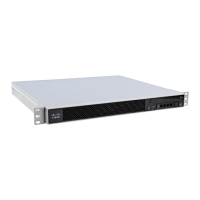1-48
Cisco ASA Series CLI Configuration Guide
Chapter 1 Configuring a Cluster of ASAs
Managing ASA Cluster Members
• Leaving the Cluster, page 1-49
• Changing the Master Unit, page 1-50
• Executing a Command Cluster-Wide, page 1-51
Becoming an Inactive Member
To become an inactive member of the cluster, disable clustering on the unit while leaving the clustering
configuration intact.
Note When an ASA becomes inactive (either manually or through a health check failure), all data interfaces
are shut down; only the management-only interface can send and receive traffic. To resume traffic flow,
re-enable clustering; or you can remove the unit altogether from the cluster. See the “Leaving the
Cluster” section on page 1-49. The management interface remains up using the IP address the unit
received from the cluster IP pool. However if you reload, and the unit is still inactive in the cluster, the
management interface is not accessible (because it then uses the Main IP address, which is the same as
the master unit). You must use the console port for any further configuration.
Prerequisites
• You must use the console port; you cannot enable or disable clustering from a remote CLI
connection.
• For multiple context mode, perform this procedure in the system execution space. If you are not
already in the System configuration mode, enter the changeto system command.
Detailed Steps
Inactivating a Member
To inactivate a member from any unit, perform the following steps.
Note When an ASA becomes inactive, all data interfaces are shut down; only the management-only interface
can send and receive traffic. To resume traffic flow, re-enable clustering; or you can remove the unit
altogether from the cluster. See the “Leaving the Cluster” section on page 1-49. The management
Command Purpose
Step 1
cluster group name
Example:
hostname(config)# cluster group pod1
Enters cluster configuration mode.
Step 2
no enable
Example:
hostname(cfg-cluster)# no enable
Disables clustering. If this unit was the master unit, a new master
election takes place, and a different member becomes the master
unit.
The cluster configuration is maintained, so you can enable
clustering again later.

